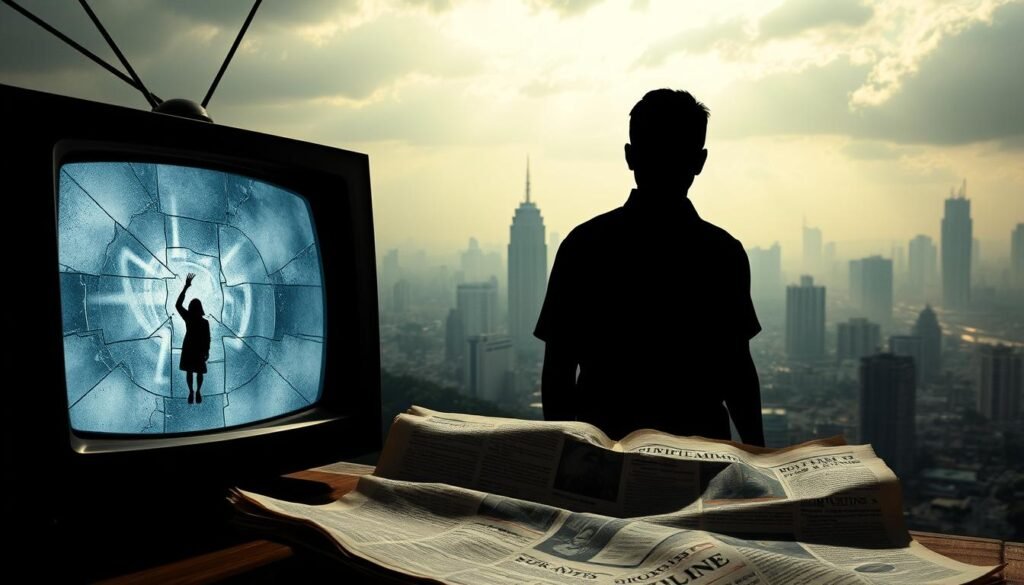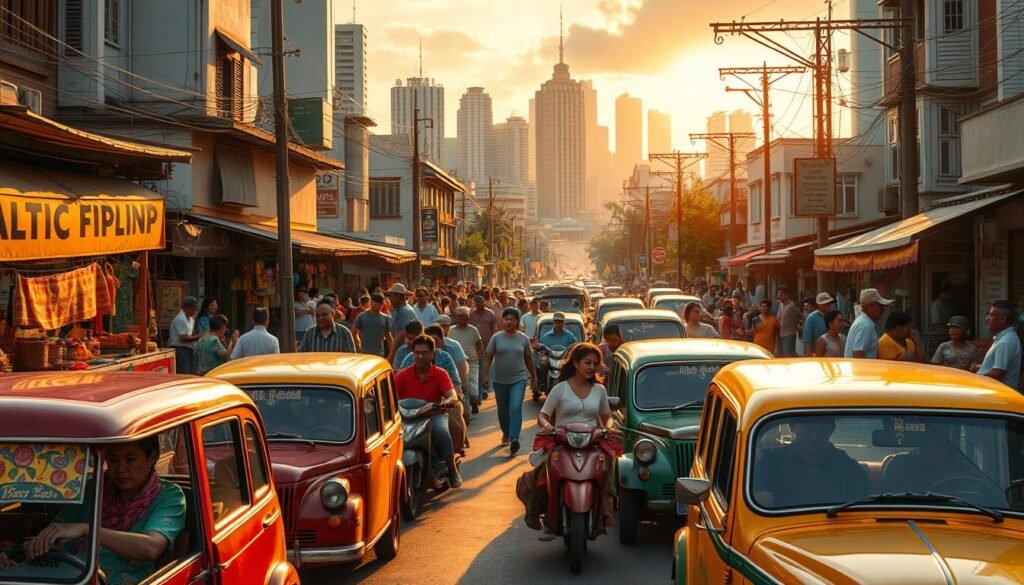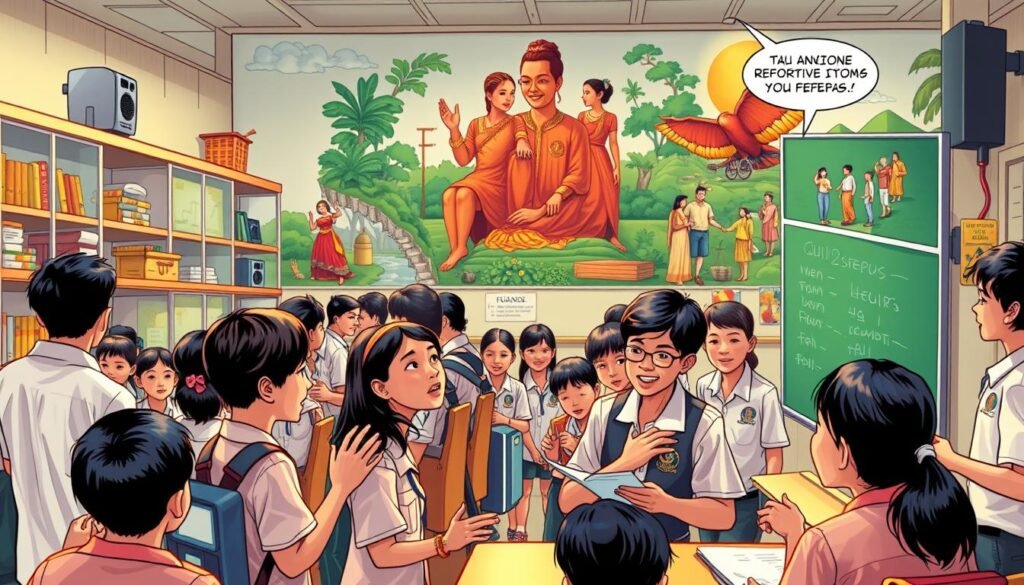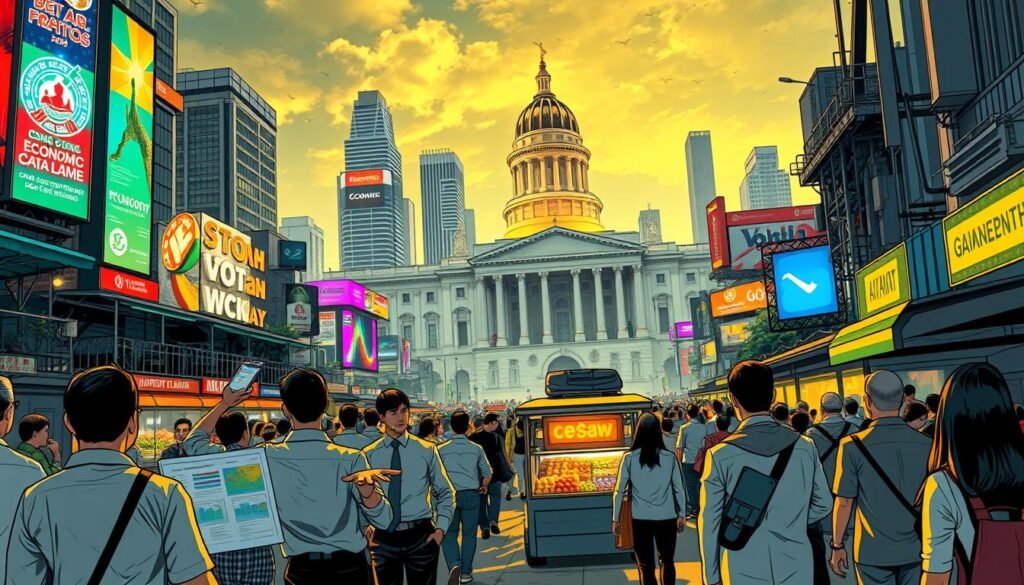In September 1972, Ferdinand Marcos declared martial law. This had a huge impact on Filipino culture. It led to many human rights abuses, like arrests, torture, and killings.
This period changed how the government kept order. It also affected the economy and people’s lives. Martial law made crime rates drop but also banned strikes, changing the economy.
The regime’s actions deeply affected the Filipino people. Their culture and way of life changed. The years after martial law saw big changes in society, economy, and politics.
Introduction to Martial Law
In 1972, martial law started a new era in the Philippines. It was a time of government control and order. This had a big impact on Filipino culture and history.
Key Takeaways
- Martial law was declared in the Philippines in September 1972, affecting Filipino Culture.
- The regime’s actions led to a decline in violent urban crime, but also resulted in human rights violations, which are crucial to understanding Martial Law.
- The implementation of martial law had far-reaching consequences for the Filipino people, shaping their culture and way of life, and requiring a thorough Historical Analysis.
- The period was marked by significant social, economic, and political changes, all of which contributed to the transformation of Filipino culture under Martial Law.
- The legacy of martial law continues to be felt in the Philippines today, with the country still grappling with the consequences of this period in its history, and its impact on Filipino Culture.
- The Historical Analysis of martial law is essential to understanding its impact on Filipino Culture and the country’s development.
- Martial law had a profound impact on the Filipino people, affecting their culture, way of life, and the country’s overall development, and its legacy continues to influence Martial Law and Filipino Culture.
Understanding Martial Law in the Philippines
The Philippines declared Martial Law on September 21, 1972. This was a major change in the country’s history. It was caused by Political Events like rising communist and Muslim separatist movements.
At first, many people supported the new regime. But soon, they opposed it as its authoritarian nature became clear.
Martial Law had a big impact on the Philippines. Over 3,000 people were killed, 34,000 tortured, and 70,000 imprisoned. The regime’s policies also led to poverty and inequality.
The Political Events of this time greatly affected the country’s development and its people.

The following table summarizes some key statistics related to Martial Law in the Philippines:
| Category | Number |
|---|---|
| People killed | 3,240 |
| People tortured | 34,000 |
| People imprisoned | 70,000 |
In conclusion, Martial Law in the Philippines was a time of big Political Events and a bad Social Climate. Knowing about this period helps us understand the country’s history and its people.
Traditional Filipino Culture Before Martial Law
Traditional Filipino Culture is all about community and unity. Before Martial Law, this was seen in the country’s customs and values. Family, community, and social bonds were very important.
The Philippines has a long history, with people living there for thousands of years. The oldest human remains found, called Tabon Man, date back about 47,000 years. This history helped shape the unique culture of the Philippines.
Some key parts of Traditional Filipino Culture include:
- Strong family ties and respect for elders
- Close-knit community relationships
- Rich cultural heritage, including music, dance, and literature

In the Pre-Martial Law era, these cultural aspects were still alive. The country’s history, especially its colonial past, influenced its culture. Knowing about Traditional Filipino Culture helps us understand the country’s history and its people.
Transformation of Social Values and Norms
The martial law period in the Philippines changed the country’s Social Values deeply. It made people see their roles in society differently. This change also affected Family Dynamics, as traditional family structures were broken, and new ones formed.
Community Relations also changed, with trust in institutions and community bonds breaking down. The loss of trust in institutions was especially big. It made people lose respect for authority and the rule of law.
Some key changes in Social Values and norms during this period include:
- Shift from traditional to modern values
- Increased emphasis on individual freedom and autonomy
- Decline of traditional family structures and emergence of new forms of family relationships

The martial law period’s impact on Social Values and norms is still felt today. It has shaped the Philippines’ Family Dynamics and Community Relations deeply. Understanding the importance of Social Values, Family Dynamics, and Community Relations is crucial for the country’s future.
The Arts Under Suppression and Resistance
The martial law in the Philippines deeply affected the arts. It led to Arts Suppression and the rise of Resistance art. Many artists and writers had to hide or leave the country to avoid being caught.
Yet, some artists kept creating. They used their work as a way to fight back against the regime. Groups like Kaisahan, started in 1976, focused on political Resistance and building a national identity. The Concerned Artists of the Philippines (CAP), formed in 1983, also worked hard to oppose the dictatorship.
But Arts Suppression wasn’t just about visual arts. Writers and musicians also faced censorship and persecution. Still, they didn’t stop creating. Many used their work to speak out against the regime.

Today, the impact of Arts Suppression and Resistance is still seen in the Philippines. Artists and writers keep using their work to tackle social and political issues. They inspire a new generation of Filipinos to fight for their rights and freedoms.
Media Control and its Cultural Implications
The martial law period in the Philippines saw strict Media Control. This included Censorship and propaganda. It greatly affected culture, limiting freedom of speech and information access. The government controlled media, silencing opposition and promoting its views through propaganda.
The effect on Press Freedom was huge. Many journalists and media outlets were muzzled. Those who kept working faced strict watch and censorship. This resulted in fewer diverse views and topics being discussed.

Yet, an underground media movement sprang up. It included alternative media and independent journalists. They fought against the regime and pushed for Press Freedom. This movement was key in keeping the country’s culture alive and supporting democracy.
Even today, martial law’s impact on Media Control and Press Freedom is seen. The Philippines has made big strides in Press Freedom. But, there’s still a need to watch and fight for media freedom.
Changes in Filipino Culture During the Era
The martial law era deeply affected Filipino Culture. It changed Language and Cultural Practices. Filipino became more widely used as a national language. Traditional festivals and customs also saw changes.
Some key changes in Filipino Culture during this time include:
- Shifts in Language usage, with a greater emphasis on Filipino and English
- Changes in Cultural Practices, such as the celebration of traditional festivals and holidays
- Impact on public behavior and social etiquette, with a greater emphasis on discipline and obedience
The martial law era also brought new Cultural Practices. For example, underground media and alternative forms of expression emerged. The Language used included code words and secret messages to evade authorities.

Educational System Reforms and Their Impact
The Philippine educational system has seen big changes. These Educational Reforms aim to bring the country together. A report by the Department of Education shows these reforms have changed education a lot. They brought in a new curriculum and set up a national education system.
Some important numbers show how these reforms have affected education:
- By 1991, more students were in school, reaching 16.5 million.
- By the Curriculum Year 2000-2001, 19,138,635 students were in basic education.
- The Department of Education oversees 40,336 public schools and 7,444 private ones.

The Educational Reforms have also updated the curriculum. They aim to make education better and more accessible. But, despite these efforts, some groups still face big challenges. The reforms’ effects on education and culture are ongoing. There’s a push to fix regional gaps and make education fit the country’s economic goals.
Religious Expression and Faith Practices
The Philippines is home to a variety of faith practices, with most people being Catholic. The Catholic Church has greatly influenced the country’s religious expression and church-state relations. The church and government have had a complex relationship, often disagreeing on human rights and social justice.
The COVID-19 pandemic has changed faith practices in the Philippines. Many religious events were cancelled or postponed. Yet, Filipinos found new ways to connect with their faith online.

Role of the Catholic Church
The Catholic Church has been a major player in church-state relations in the Philippines. It has spoken out against government policies, pushing for social justice and human rights.
Impact of Martial Law
Martial law in the Philippines affected faith practices and religious expression a lot. The government targeted religious groups and restricted gatherings. Still, the church continued to advocate for justice and human rights, even challenging the government.
Economic Policies and Cultural Shifts
The Economic Policies during martial law greatly affected the Philippines’ economy and culture. The government aimed to boost national development through new industries and foreign investment. This led to a growing consumer culture and a new middle class. As a result, economic development played a big role in Cultural Shifts in the country.
The Philippines’ economy saw big changes during this time. The share of manufacturing in GDP fell from 27.6% in 1980 to 23.2% in 2015. Meanwhile, agriculture’s share dropped from 23.5% in 1980 to 9.5% in 2015. These changes deeply influenced the country’s culture, introducing a new consumer culture and middle class.

Some key statistics show the impact of Economic Policies on the Philippines’ economy and culture. For example:
- The wealth of the 10 richest Filipinos grew by 220% from 2010 to 2015.
- The net income of the top 1,000 corporations increased by 41% from 2010 to 2014.
- The real value of the average daily basic pay of wage and salary workers rose by only 5.3% between 2010 and 2015.
These statistics highlight the significant Cultural Shifts in the Philippines due to Economic Policies. As the country develops further, it’s crucial to think about these policies’ effects on the economy and culture. We must strive for a more fair and sustainable society.
The Rise of Protest Culture
The martial law period in the Philippines saw a vibrant Protest Culture
Music and Literature were key in this movement. Many artists and writers used their work to push for social change. They resisted the government’s oppressive policies.
Music was used as a powerful tool for protest. Songs criticized the government and advocated for social justice. Literature also played a crucial role, with writers challenging the regime and pushing for change.
Street Art became a common form of protest. Artists used graffiti and other visual expressions to challenge the government. They promoted social justice through their work.
Key features of the Protest Culture include:
- The use of Music and Literature as forms of resistance
- The emergence of Street Art as a form of visual protest
- The role of artists and writers in promoting social change and challenging the government
Intergenerational Impact on Filipino Identity
The Filipino Identity has been shaped by many historical events. These include centuries of colonization, Japanese occupation, and the Martial Law era. These experiences have caused collective historical trauma, affecting not just individuals but also communities and families.
Dr. Fabiana Franco, a clinical psychologist, says intergenerational trauma can be passed on. This happens through parenting behaviors and changes in gene expression. It shows how important it is to address and understand the impact of Memory and Trauma on Filipino families and communities.
Preserving Cultural Heritage is also key. Efforts to keep the history and culture of the martial law period alive are vital. This helps individuals and communities process their experiences and move forward. It involves sharing stories, documenting historical events, and creating cultural artifacts that reflect the Filipino Identity.
Some important aspects of intergenerational impact on Filipino Identity include:
- Collective historical trauma and its effects on mental health
- The importance of addressing and understanding Memory and Trauma
- The preservation of Cultural Heritage and its role in shaping Filipino Identity
By acknowledging and addressing these factors, individuals and communities can heal. They can build a stronger sense of Filipino Identity.
Modern Filipino Culture: Martial Law’s Lasting Legacy
The declaration of Martial Law in 1972 deeply affected the Philippines. It shaped the country’s politics, economy, and social values. Today, Modern Filipino Culture still shows the scars of this time, with Martial Law’s legacy still influencing the nation.
The effects of Martial Law are seen in the country’s social values. Many Filipinos still face the consequences of a suppressed democracy. The 14-year rule of one man has left a mark on the nation’s political landscape. Issues like corruption and elite dominance remain common.
Some key statistics show Martial Law’s impact:
- 3,257 known extrajudicial killings
- 35,000 documented cases of torture
- 737 individuals reported as “disappeared”
- Approximately 70,000 people incarcerated under Martial Law
The Modern Filipino Culture is complex and shaped by history, including Martial Law. As the Philippines grows, it’s crucial to learn from the past. This way, we can avoid repeating Martial Law’s mistakes.
Conclusion: Cultural Resilience and Transformation
The Filipino culture has shown amazing cultural resilience when facing tough times, like martial law. This strength comes from strong family bonds, community support, faith, humor, and being able to adapt. These traits have been passed down through generations.
Over the years, especially during the 300+ years of Spanish rule, Filipino culture has changed a lot. The arrival of Catholicism, the use of Spanish surnames, and Spanish food have all shaped the Philippines’ unique identity.
Even with martial law and other tough times, Filipinos have shown they can cope and adjust. This shows the country’s cultural resilience. It proves the Filipino people’s strength and resourcefulness, which will keep guiding the country’s path forward.
FAQ
What is martial law and how did it impact Filipino culture?
Martial law means a country is ruled by the military. In the Philippines, it changed culture a lot. It stopped traditional practices, led to resistance art, and changed social values.
What were the key political events that led to the declaration of martial law in the Philippines?
The rise of communist and Muslim separatist movements was key. These threats made the government declare martial law to keep stability.
How did martial law affect traditional Filipino culture?
Martial law hurt traditional culture a lot. It banned customs, censored art, and changed social norms. This pushed the culture towards being more modern and Western.
What was the role of the arts in resisting martial law in the Philippines?
The arts were very important in fighting against martial law. Artists and writers used their work to challenge the regime. They made art, music, and literature that inspired people to stand up against the government.
How did martial law affect the media in the Philippines?
Martial law hurt the media a lot. It censored news, spread propaganda, and silenced dissent. This made it hard for the media to report on the regime’s wrongdoings.
What were the long-term effects of martial law on Filipino culture and society?
Martial law changed society and culture a lot. It made society more modern and Western. It also affected democracy and the economy, shaping the country’s future.
How did martial law affect the educational system in the Philippines?
Martial law changed education a lot. It introduced a new curriculum and a national education system. This aimed to unite the country but also limited freedom and critical thinking.
What was the impact of martial law on religious expression and faith practices in the Philippines?
Martial law affected religion a lot. It changed the church-state relationship and the role of the Catholic Church. Religious movements and resistance emerged, fighting for change and human rights.
How did martial law affect the economy in the Philippines?
Martial law changed the economy a lot. It introduced economic policies for development, grew a consumer culture, and created a new middle class. This transformed the economy and had a lasting effect.
What is the legacy of martial law in modern Filipino culture?
Martial law’s legacy is complex. It affects social values, democracy, and the economy. Efforts to preserve culture and promote justice and human rights are ongoing.
Source Links
- Philippines – Martial Law, Marcos, Dictatorship | Britannica
- Five things to know about Martial Law in the Philippines
- The Methods of Regime Survival
- Why Did Marcos Declare Martial Law?
- Lessons from Philippines’ Martial Law Still Hold for the Church Today – Christianity Today
- Revisionist Narratives and the Revival of the Marcos Family in the Philippines
- History of the Philippines
- History of the Philippines | People, Spain, United States, Revolution, Map, & Facts | Britannica
- On Martial Law at 50: Fact-Checking the Marcos Story, Countering the EDSA History | Heinrich Böll Foundation | Southeast Asia
- ‘The House Is Still Burning’: Censorship, Pandemic and Art in the Philippines
- Philippine Art as Reclamation of Space and Place – Confluence
- The Print Media: A Tradition of Freedom – National Commission for Culture and the Arts
- Radio as a Way of Life – National Commission for Culture and the Arts
- Culture of the Philippines
- Philippines – Culture, Diversity, Traditions | Britannica
- From Indigenous Roots to Global Fusion: The Evolution of Filipino Culture and Its Impact on Today’s Workforce
- Microsoft Word – 05 Guzman_4_.doc
- In Retrospect and Prospect: An Analysis of the Philippine Educational System and the Impact of K-12 Implementation
- When expressions of faith in the Philippines becomes a potential COVID-19 ‘superspreader’
- Understanding Folk Religiosity in the Philippines
- Economic history of the Philippines
- Filipinos denied economic, social and cultural rights
- The Philippine economy under the pandemic: From Asian tiger to sick man again?
- Philippine Revolution | Facts, Leaders, & Significance | Britannica
- Democratic expressions amidst fragile institutions: Possibilities for reform in Duterte’s Philippines
- Philippines Protesters Decry Alleged Injustices Under Marcos
- How I’m Healing From Intergenerational Trauma In My Filipino Family
- Intergenerational Learning and Sikolohiyang Pilipino: Perspectives from the Philippines
- Martial law under Ferdinand Marcos
- The People Power Revolution, Philippines 1986
- The Spanish Influence on Filipino Culture and Language
- Toxic Filipino Culture (and why do we need to discuss this on the table?)

